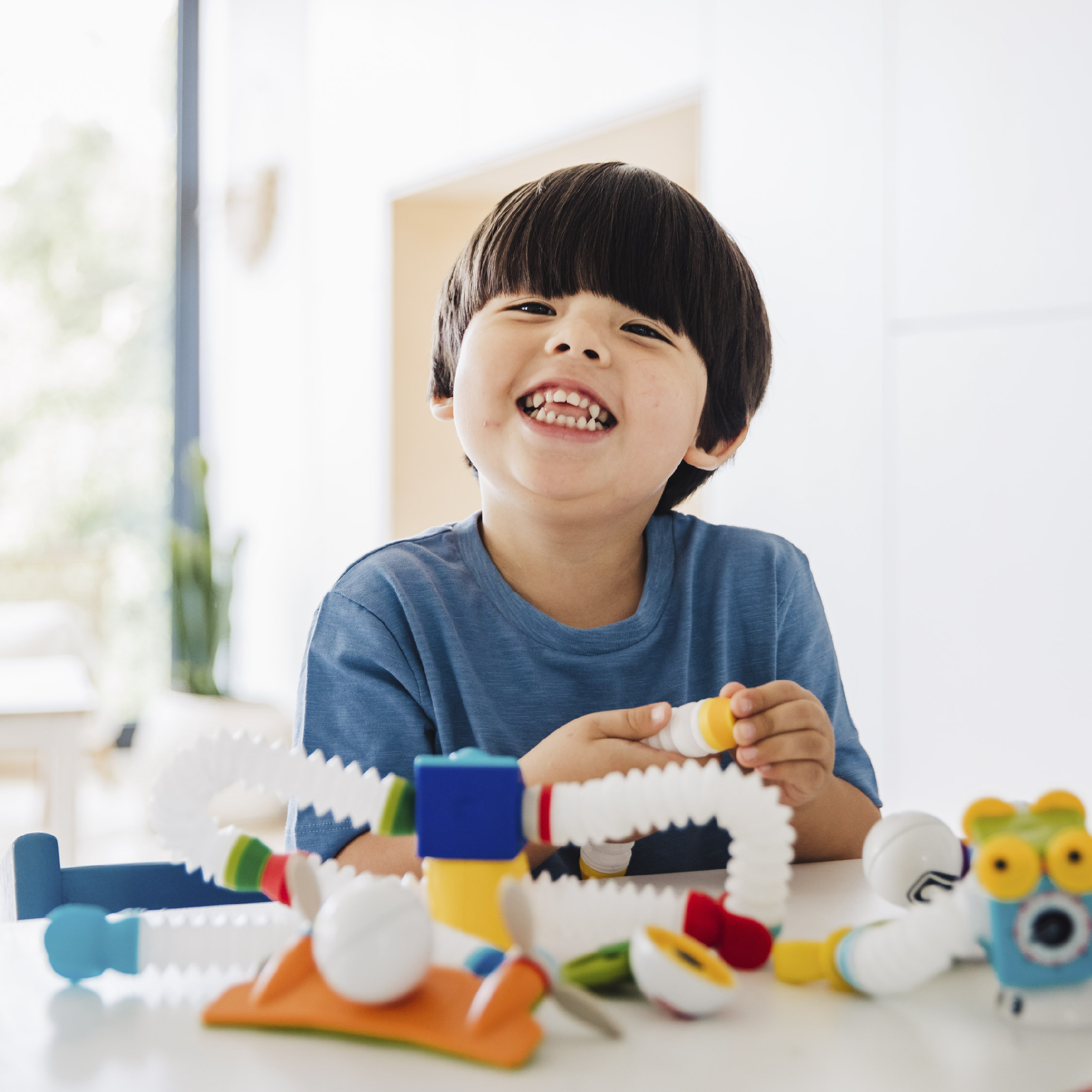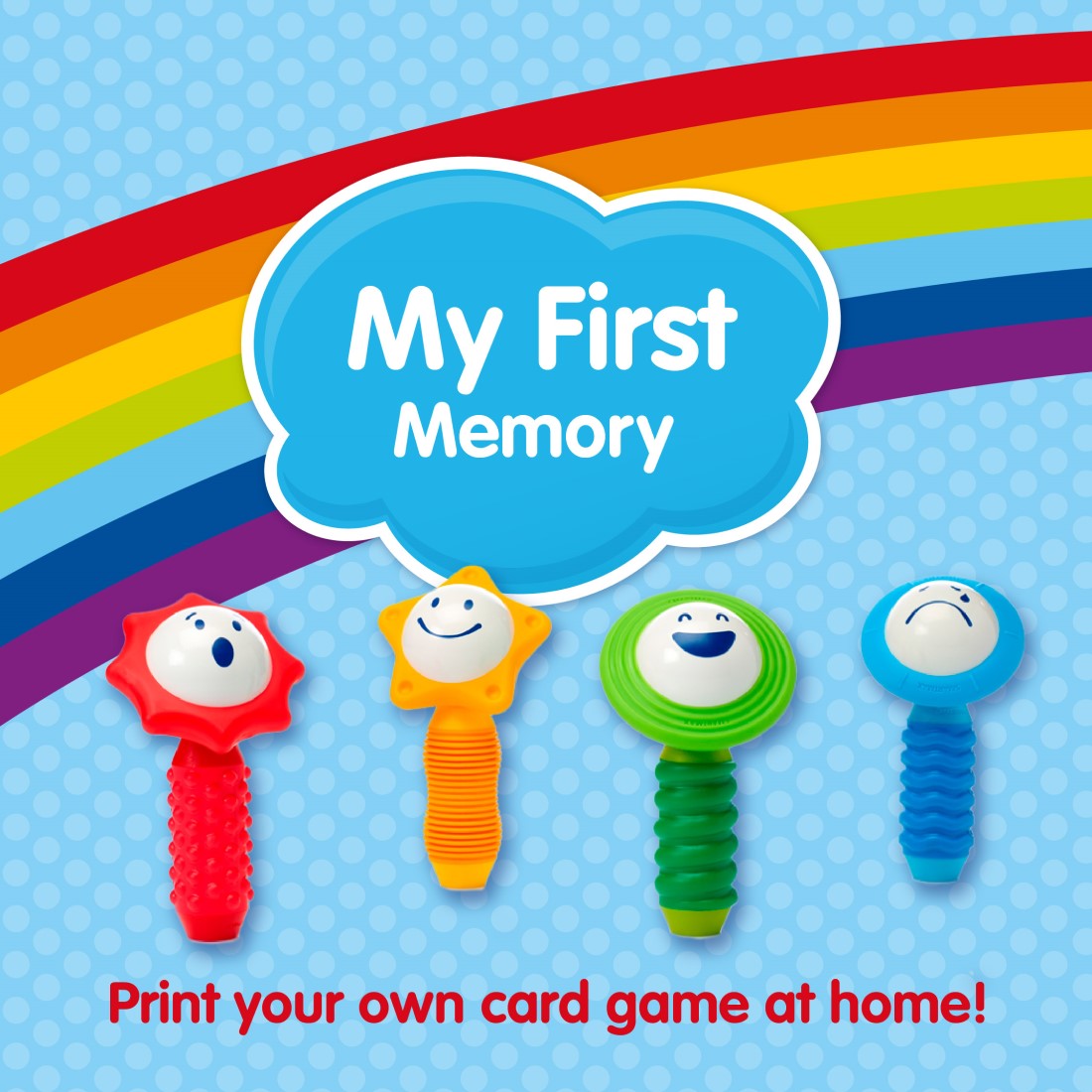Why play memory games?
Memory games improve your working memory. This is the memory that you can access and use immediately. It’s important for e.g., reading, problem-solving and learning. Memory games for toddlers improve their attention span and concentration, it helps them think faster, and trains visual memory. Extra benefit, while playing together, you are also bonding and creating lovely memories!
A multisensory approach
Both kids and adults memorise better when things are brought via a multisensory approach. Try to use sounds, touch, tastes, and sight when playing. This will train their memory in several ways (and gives you much more variety in inventing memory games).

Fun memory improving games to play with My First Sounds and Senses
Hide an object
This is a fun and easy game you can play with your little one! Take all the My First Sounds and Senses items and put them in front of your little one. Now ask your child to name all the different pieces. Then, ask your children to close their eyes while you hide one of the pieces. Let them open their eyes and tell you which piece is missing. If this is too difficult, you can always play an easier version first by hiding one of the items under a pillow or blanket and ask your little ones to find them. This will stimulate their visual and short-term memory.
Play it back
A game that will tickle your kids’ auditive processing system! Use the My First Sounds and Senses pieces to create a rhythm. Keep it simple at the beginning by only using one rattle ball or by clinking the magnetic bars together and ask your child to play back the same sounds. Once your kid gets the hang of it, make it more difficult by repeating patterns. If you want to make it harder, you can also ask your child to recreate the exact sound you made. E.g., every ball in the My First Sounds and Senses set makes a different rattling sound you can use. And don’t forget to let your child invent their own tune you need to replay! This game does not only benefit memory, but also listening skills.
Mimic it back
A variation on the previous game, is to use the facial expressions on the balls and ask your little one to mimic them. Show them first one ball and ask them to name the emotion on the ball (it’s recommended to use the most obvious emotions on the balls first). Now hide the ball and ask your little one to imitate the emotion on the shown ball. You can make it more difficult by showing a couple of emotion-balls after one another, and then ask your child to imitate all of them in the correct sequence.
Sorting game
Sorting memory games help boost concentration. Use 4 coloured post-its (or make 4 coloured cards), one red, one yellow, one green and one blue. Now ask your child to put the 8 My First Sounds and Senses pieces on the correct coloured post-it (the green bar and green face on the green post-it, …). If you want to make it more difficult, you can ask them to sort the faces based on positive or negative feelings or by warm and cold colours.

Download for free our My First Sounds & Senses Memory game!
Another wonderful way to train your child’s memory, is with a classic memory game. We created one especially for small children. How does it work? Single-sided print the free memory game (download here) and cut out the squares. For young children from the age of 2, we would suggest to only use the images on the first page. Now start by putting 3 pairs of cards from the first page face down before your kid. Let your child turn around the first card and describe what they see. Next, let them turn the second card. If that one is identical, your child can keep both cards. If not, the two cards need to be turned back face down. Once your pre-schooler gets a hang of it, you can add the images of the second page for an extra difficulty level! Don’t make the game too difficult at the beginning to avoid frustrations.
More information and sources:
Seul McLeod (18 August2022). Piaget’s stages of cognitive development. Simply Psychology. https://www.simplypsychology.org/piaget.html
Alicia Nortje (3 May 2021). Piaget’s Stages: 4 Stages of Cognitive Development & Theory. Positive Psychology. https://positivepsychology.com/piaget-stages-theory/#preoperational
Rohit Garoo (20 December 2022). 23 Activities To Promote Cognitive Development In Toddlers. Mom Junction. https://www.momjunction.com/articles/cognitive-development-activities-for-toddlers_00704930/#cognitive-activities-to-boost-a-toddlers-memory
Rachel Meyers (24 April 2012). Begin exercising long-term memory in toddlers with these at-home exercises. Michigan State University. https://www.canr.msu.edu/news/begin_exercising_long-term_memory_in_toddlers_with_these_at-home_exercises
Mrunal (9 January 2019). Playing Memory Games With Toddlers. First Cry Parenting. https://parenting.firstcry.com/articles/playing-memory-games-with-toddlers/
Tanja Mcilroy (7 December2022). 9 Simple Memory Games for Kids. Empowered Parents. https://empoweredparents.co/memory-games-children/
Oxford Learning (30 October 2017). 11 Ways To Improve Your Child’s Memory Power. Oxford learning. https://www.oxfordlearning.com/11-ways-to-improve-memory-for-kids/

